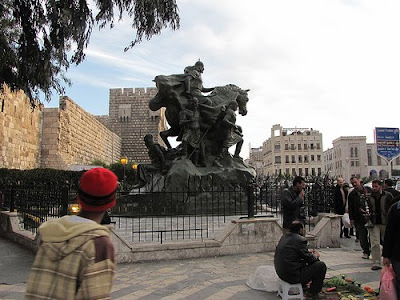Sights from Damascus, Syria
Damascus or Ash'Sham or the Pearl of the East, is old. Very old. It has a long history and is said to be the oldest continuously inhabited city in the world; some say that it has been inhabited, continuously for the last 5,000 years. Conquered by Khalid Ibn Walid in 635, it later became the center of Islam and its seat of power.
A bronze statue of Salah ad-Din Yusuf ibn Ayyub in front of the Damascus Citadel. Unveiled in 1993, it is one of the most noticeable structures in the city. At the height of Al Ayyubi's power, his rule stretched from Syria to Egypt to Yemen.
The city has some of the most hospitable and friendliest people. They are charming and cordial; and always willing to assist. From early morning the city starts bustling with people.
Some say that Damascus has two million people and yet some say six million. In most parts of the city, it is crowded with people. Especially near the Citadel. At times, it can get really frenetic.
Of all places in the city, the most fascinating, most charming and most interesting is the Old City.
Filled with bazaars and alleys; minarets and mosques; and fountain courtyards, street-cart vendors, butcheries and coffeehouses. Tailors and blacksmiths. And grave yards. At times, while walking through these labyrinths of streets - one feels taken centuries back. And if not careful, it is easy to get lost in the very similar looking, narrow streets. Many houses here look very similar and may look very simple from the outside but inside they are extensively and exquisitely decorated.
Most of the streets in and near the Old City, are filled with all kinds of vendors hawking all kinds of goods: fruits and vegetables; clothes, shoes, cigarettes and many other items.
From early morning to late at night, the streets are noisy with people. These streets, for centuries, have had the same kind of incessant activity. Activity at different periods in its history - by different people, different races, varying cultures and religions.
No other place in Damascus is as bewitching and unforgettable; and very noisy, as the 500 meters long, world famous Souq Al Hamidiyeh. Filled with people of all kinds. And shop keepers with all kinds of goods, the souq is at times so crowded that it is almost impossible to move or shop. The souq is filled with handicrafts - including embroidery on brocades, souvenirs, silver decoration on copper, carpets; an extensive variety of ornaments, jewelery shops, halawiyat shops; and restaurants. It is best to take time walking around including in to the narrower back streets. When shopping, bargain hard.
Like many old, great cities - one of the main reasons for Damascus's location and development is the presence of water. The most important river in the city is the Barada, which flows from the Eastern Lebanon Mountains and through the city. After centuries of being used, it is more of a stream and looks overused, dirty and contaminated.
The style and architecture of buildings in the city is a mixture of the old and the new, Arab and European, colonial and indigenous. Roman, Byzantine, Islamic and Ottoman structures are all over. Successive eras have built next to or on top of older ones.
Buildings that look more of Paris or Milan, stand next to old Damascene structures; or Soviet styled, box like houses. All these make the city a unique and very interesting place.
Its main hotels too, reflect this diverseness. Above: the old, plain Damascus International Hotel.
And the new, above: the Prince Al Waleed owned and splendidly built Four Seasons Hotel.
Damascus is a city of gates.
Some, very old.
And walls.
The best place to have a great, spectacular view of the city is to go through the upscale, diplomatic area of the city and its neat, broad boulevards, leafy green parks - and up to Jabal Qassioun. From up there, the view is truly magnificent. Up there, is utterly quiet and serene too. It is also much cooler, greener and cleaner than most of the city. A city that has been gone through by great Prophets and saints; conquerors and dictators; great merchants and explorers; wise men and fools. A city that, from time immemorial, has been at the center of international politics; and it still is. A city, that through out history has been visited and coveted by many. Still, many visit Damascus. And still many covet it.


















